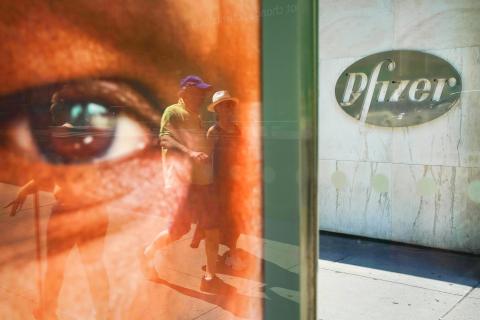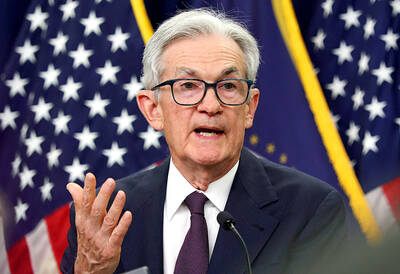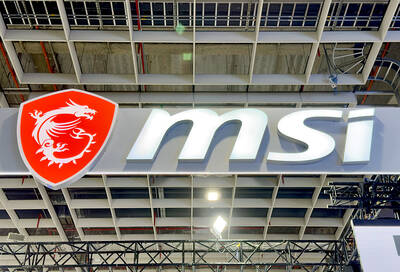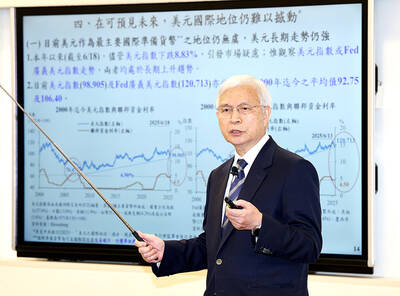Pfizer Inc on Monday announced that it would merge its off-patent drug business with generic drugmaker Mylan NV to create a global leader in low-cost treatment, a business that faces significant political pressure in the US.
The new entity, which is to be renamed upon the deal’s closure, would have a portfolio that includes impotence drug Viagra, cholesterol pills Lipitor, painkiller Lyrica and the life-saving EpiPen treatment for severe allergic reactions.
The merger comes amid rising competition in generic drugs from companies in India and elsewhere, a segment of pharma that is known for having low barriers to entry and commodity-like products.

Photo: AFP
Joining forces with Pfizer’s off-patent division, called Upjohn, would give Mylan access to more international markets.
The deal is also expected to result in US$1 billion in annual cost savings starting in 2023, the companies said.
“The combined organization will have a presence across nearly every continent and major market, establishing a new leadership position in Asia, and offering products capable of treating all major therapeutic areas,” said Mylan chairman Robert Coury, who is to serve as executive chairman of the new company.
This marks the latest move by Pfizer, which has grown into one of the world’s biggest pharma companies through a string of acquisitions.
The new company will be 57 percent owned by Pfizer shareholders and 43 percent owned by Mylan investors.
Upjohn president Michael Goettler is to serve as CEO of the new firm, while Mylan CEO Heather Bresch is to leave the company.
Pfizer, meanwhile, has announced deals in recent months to combine its consumer healthcare business with GlaxoSmithKline PLC’s unit, and to spend US$11.4 billion to acquire Array BioPharma Inc, which is known for drugs in development focused on oncology and rare disease.
Pfizer chief executive Albert Bourla said the deal with Mylan would sharpen the company’s focus on “breakthroughs that change patients’ lives.”
Separately, Pfizer reported that second-quarter profit jumped 30.3 percent to US$5 billion, due in part to a large one-time boosts from a favorable US tax settlement and a lower tax rate after the late 2017 US tax cut signed by US President Donald Trump.
Revenues dropped 1.5 percent to US$13.3 billion.
Pfizer also cut some of its financial forecasts for this year, citing the accounting of the GlaxoSmithKline and Array transactions.
Mylan’s share price surged 12.6 percent to end the day at US$20.78, while Pfizer fell 3.8 percent to US$41.45.

DIVIDED VIEWS: Although the Fed agreed on holding rates steady, some officials see no rate cuts for this year, while 10 policymakers foresee two or more cuts There are a lot of unknowns about the outlook for the economy and interest rates, but US Federal Reserve Chair Jerome Powell signaled at least one thing seems certain: Higher prices are coming. Fed policymakers voted unanimously to hold interest rates steady at a range of 4.25 percent to 4.50 percent for a fourth straight meeting on Wednesday, as they await clarity on whether tariffs would leave a one-time or more lasting mark on inflation. Powell said it is still unclear how much of the bill would fall on the shoulders of consumers, but he expects to learn more about tariffs

Meta Platforms Inc offered US$100 million bonuses to OpenAI employees in an unsuccessful bid to poach the ChatGPT maker’s talent and strengthen its own generative artificial intelligence (AI) teams, OpenAI CEO Sam Altman has said. Facebook’s parent company — a competitor of OpenAI — also offered “giant” annual salaries exceeding US$100 million to OpenAI staffers, Altman said in an interview on the Uncapped with Jack Altman podcast released on Tuesday. “It is crazy,” Sam Altman told his brother Jack in the interview. “I’m really happy that at least so far none of our best people have decided to take them

PLANS: MSI is also planning to upgrade its service center in the Netherlands Micro-Star International Co (MSI, 微星) yesterday said it plans to set up a server assembly line at its Poland service center this year at the earliest. The computer and peripherals manufacturer expects that the new server assembly line would shorten transportation times in shipments to European countries, a company spokesperson told the Taipei Times by telephone. MSI manufactures motherboards, graphics cards, notebook computers, servers, optical storage devices and communication devices. The company operates plants in Taiwan and China, and runs a global network of service centers. The company is also considering upgrading its service center in the Netherlands into a

NOT JUSTIFIED: The bank’s governor said there would only be a rate cut if inflation falls below 1.5% and economic conditions deteriorate, which have not been detected The central bank yesterday kept its key interest rates unchanged for a fifth consecutive quarter, aligning with market expectations, while slightly lowering its inflation outlook amid signs of cooling price pressures. The move came after the US Federal Reserve held rates steady overnight, despite pressure from US President Donald Trump to cut borrowing costs. Central bank board members unanimously voted to maintain the discount rate at 2 percent, the secured loan rate at 2.375 percent and the overnight lending rate at 4.25 percent. “We consider the policy decision appropriate, although it suggests tightening leaning after factoring in slackening inflation and stable GDP growth,”